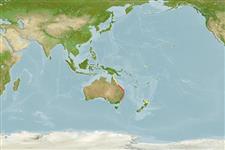>
Tetraodontiformes (Puffers and filefishes) >
Monacanthidae (Filefishes)
Etymology: Cantheschenia: Greek, kanthos = the outer or inner corner of the eye, where the lids meet, 1646 + Greek, schein, eko = to carry (Ref. 45335); grandisquamis: Name from the Latin word 'grandisquamis' (meaning large-scale), for the relatively large prominently outlined scales on the mid-side of the body.
Environment: milieu / climate zone / depth range / distribution range
Ecologia
marino associati a barriera corallina; distribuzione batimetrica ? - 29 m (Ref. 58018). Temperate
Western Pacific: Capricorn Group to New South Wales, Australia.
Size / Peso / Age
Maturity: Lm ? range ? - ? cm
Max length : 26.0 cm TL maschio/sesso non determinato; (Ref. 2334)
Short description
Chiavi di identificazione | Morfologia | Morfometria
Raggi dorsali molli (totale) : 39; Raggi anali molli: 36; Vertebre: 19. Diagnosis: Relatively large scales on side of body with prominent outlines forming a reticulate pattern, each scale with many small spinules arranged in series radiating from a slightly larger central spinule. Soft dorsal rays 39, anal rays 36, pectoral rays 13. Color pattern consists of a dark brown to yellowish brown background with a patch of iridescent blue spots on side of throat and breast; a similarly colored line along basal sheath of both soft dorsal and anal fins, and upper and lower 4 rays of caudal fin dark blue, with a black bar along posterior margin, the remainder of fin yellow-orange (Ref. 35708).
In sheltered coastal and offshore reefs. Uncommon (Ref. 9710).
Life cycle and mating behavior
Maturità | Riproduzione | Deposizione | Uova | Fecundity | Larve
Randall, J.E., G.R. Allen and R.C. Steene, 1990. Fishes of the Great Barrier Reef and Coral Sea. University of Hawaii Press, Honolulu, Hawaii. 506 p. (Ref. 2334)
IUCN Red List Status (Ref. 130435: Version 2024-1)
Threat to humans
Harmless
Human uses
Strumenti
Special reports
Download XML
Fonti Internet
Estimates based on models
Preferred temperature (Ref.
123201): 21.4 - 26.7, mean 25.2 °C (based on 181 cells).
Phylogenetic diversity index (Ref.
82804): PD
50 = 0.7500 [Uniqueness, from 0.5 = low to 2.0 = high].
Bayesian length-weight: a=0.01995 (0.00956 - 0.04164), b=2.93 (2.76 - 3.10), in cm total length, based on LWR estimates for this (Sub)family-body shape (Ref.
93245).
Trophic level (Ref.
69278): 2.9 ±0.4 se; based on size and trophs of closest relatives
Resilienza (Ref.
120179): Medio, tempo minimo di raddoppiamento della popolazione 1.4 - 4.4 anni (Preliminary K or Fecundity.).
Fishing Vulnerability (Ref.
59153): Low vulnerability (16 of 100).
Nutrients (Ref.
124155): Calcium = 16.4 [6.1, 44.0] mg/100g; Iron = 0.236 [0.106, 0.577] mg/100g; Protein = 18.3 [16.0, 20.5] %; Omega3 = 0.256 [0.105, 0.555] g/100g; Selenium = 6.65 [2.66, 17.94] μg/100g; VitaminA = 39.9 [8.5, 197.8] μg/100g; Zinc = 0.645 [0.383, 1.122] mg/100g (wet weight);
